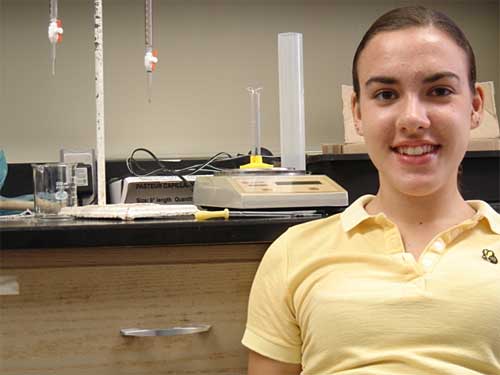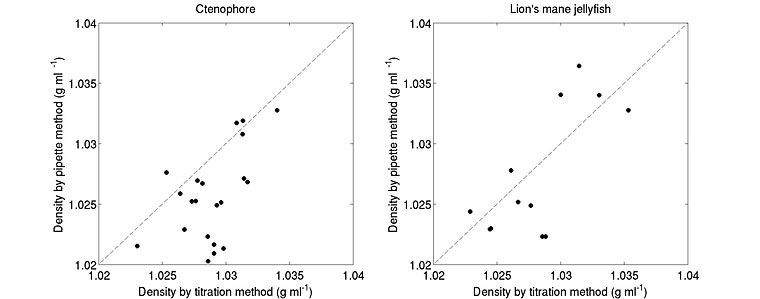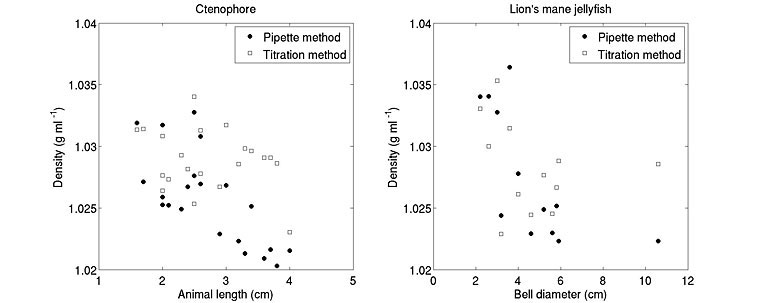
[ Lay Language Paper Index | Press Room ]
Joseph D. Warren, joe.warren@stonybrook.edu
Joy N. Smith
School of Marine and Atmospheric Sciences, Stony Brook University
Stony Brook, NY 11794
Popular version of paper 3aAB11. “Measurement of material properties of two gelatinous, coastal zooplankton”
Presented 11:05 a.m. Thursday morning, November 29, 2007
154th ASA Meeting, New Orleans, LA
Measurements of the density and the speed of sound of two gelatinous marine animals (comb jelly, Lion's Mane jellyfish) were measured (Fig. 1 below).

These values are important to know in order to use sound to measure animal populations in the marine environment. Our measurements indicate that these animals are only slightly (a few percent) denser than the surrounding seawater, that is they are (overall) extremely squishy. However, changes in animal density were observed with animal size, suggesting that some animals may have to expend more energy to remain floating in the water.
Jellyfish and other gelatinous animals inhabit many oceanic, coastal, and estuarine environments (Fig. 2, above). These animals exhibit an enormous variety of shapes, sizes, and colors and can also be very important to how marine ecosystems function. In many regions in the United States and also the world, blooms (large populations of gelatinous animals) occur and these animals may utilize many resources which could negatively impact other animals in the ecosystem (such as larval fish or shellfish). Because these animals are primarily composed of water, they can be extremely fragile and delicate. Many marine organisms are surveyed by towing a net through the water, however net tows will often damage or destroy gelatinous animals resulting in errors in estimating their natural abundance and distribution. Acoustic echosounders (essentially a scientific fish-finder) are a non-destructive measurement method that is regularly used to survey populations of fish and zooplankton (small marine animals).An echosounder transmits sound energy into the water column and then listens for echoes that are reflected back to it. By looking at the energy that is reflected by the water column and identifying what types of scatterers are present, this information can be used to estimate the number of animals in the water column. However, in order to use acoustics to study jellyfish populations, we need to understand how these animals reflect or scatter sound energy.
Many different factors determine how efficiently a marine organism will reflect sound energy. Animal size and shape, and the frequency (or pitch) of sound sent into the water column can all affect how much energy an animal reflects. In addition, differences in the body composition of the animal and how it differs from the surrounding seawater is particularly important to know. The density (ratio of mass to volume) and speed of sound of the animal's body are critically important to know; however, these two parameters are not easy to measure. This study reports density and sound speed measurements made from two different types of animals. Ctenophores (comb jellies) and Lion's Mane jellyfish were collected from local bays in Long Island, New York. Individual animals had their density measured by two different methods and groups of animals had their sound speed measured.

For both types of gelatinous zooplankton, the two different methods produced similar values of the density of the animal (Fig. 3). It should be noted that these measurements are difficult to make because the density of the animal is only a few percent different than the seawater. Because these animals are so close in density to seawater, small differences in their density can have very large impacts when acoustic echosounder data are converted into estimates of animal populations. We also examined how animal density varied with animal size. The smallest animals had the greatest difference in density from their surroundings and as size increased, the animal density decreased (Fig. 4, below).

These results may be important to take into consideration since animals with greater differences in density from seawater will have to expend more energy to remain neutrally buoyant in the water column. More information on this work can be found in our in the Journal of the Acoustical Society of America.
[ Lay Language Paper Index | Press Room ]